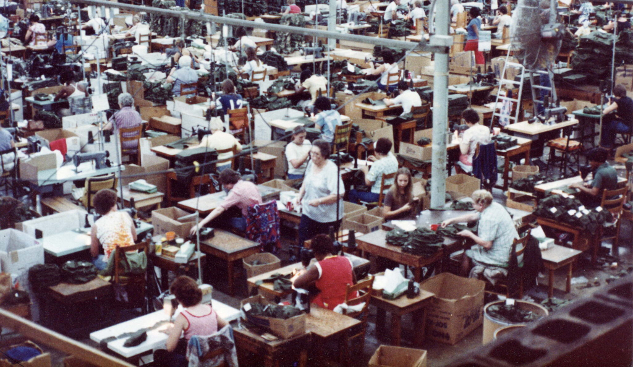
In This Article
- Did Peter Navarro's Harvard background lend false legitimacy to bad policy?
- Why do tariffs fail in today’s high-tech global economy?
- Is economic nationalism just elite-driven nostalgia?
- What can history teach us about protectionism’s limits?
- What real alternatives exist for revitalizing American industry?
The Harvard-Stamped Hammer Looking for a Nail
by Robert Jennings, InnerSelf.comNavarro didn’t stumble into his role as Trump’s trade whisperer. He came equipped with academic prestige and a thick portfolio of China-bashing books. What he lacked was any real grasp of how global economics had evolved since Alexander Hamilton’s time. Navarro’s view of trade policy was rooted in the fantasy that if you just slap enough tariffs on imports, American manufacturing will magically rise from the ashes like a patriotic phoenix.
The problem? We’re not in 1791. Hamilton’s America was building industry from scratch, with a surplus of cheap labor and minimal global competition. Navarro’s America is neck-deep in automation, supply chain integration, and a labor force that isn’t exactly lining up to return to the sewing factory. Yet Navarro marched ahead, waving his tariff wand like it was a silver bullet.
Tariffs in Theory, Trade Wars in Practice
The textbooks Navarro likely read at Harvard probably told him tariffs can help protect "infant industries." That might’ve been true in the 1800s. But today, tariffs don’t revive industries — they raise prices, trigger retaliation, and squeeze working-class families who are already fighting to keep their heads above water.
The US pushed for broad tariffs on steel, aluminum, and a host of Chinese goods. The result? American companies paid more for materials. Exporters got hit with retaliatory tariffs. Farmers lost access to foreign markets. And consumers, you guessed it, paid the price. All while manufacturing jobs barely budged, automation marched on, and multinational corporations found new loopholes.
America Doesn't Want Its Sewing Machines Back
Even if the tariff plan worked, who’s lining up to take those jobs? Most Americans don’t want to work in sweatshops, and for good reason. The world moved on. Workers want dignity, stability, and opportunity — not a return to industrial-age drudgery. You can’t build a future economy by resurrecting a past no one wants back.
I once owned what had originally been a coal miners’ union hall — a building that had been repurposed into a sewing factory in the post-industrial shuffle. At one point, it was humming with life. Ninety women from a small mountain town stitched ski clothing for Head, the brand famous for racing gear and elite skiers. It was honest work. It put food on the table and gave the community purpose. But then the globalization train came barreling through. The factory closed. The jobs vanished — not because the work stopped being valuable, but because it was suddenly cheaper to have it done halfway around the world.
What happened next wasn’t unique. That little town never recovered. Houses now sit on the market for pennies on the dollar — some unsellable even decades later. The infrastructure is still there, ghostlike, a testament to broken promises. And it’s not just that town. This is the story of countless communities across the Rust Belt, the Appalachian corridor, the rural South. The same story, repeated town by town, factory by factory: industry out, despair in. And while Washington patted itself on the back for opening global markets, it forgot to build a ramp for those it left behind.
So when someone like Peter Navarro talks about "bringing back jobs" with tariffs and tough talk, it hits a nerve — not because it's right, but because it touches real pain. That pain is real. The betrayal is real. But the solution? That’s where it all goes off the rails. Because America’s working class doesn’t want to sew ski jackets for $8 an hour under flickering fluorescent lights. They want opportunities that fit the century they live in. They want to build, invent, lead — not compete with overseas factories that pay their workers pennies.
This taffiff fantasy rests on the assumption that those factories were just waiting to be switched back on, like flipping a light. But many of those jobs didn’t disappear because of trade alone. They disappeared because of technology. Automation now does in one shift what it used to take 30 people a day to accomplish. Even if the sewing machines came back, they’d be controlled by robots, not rehiring the local workforce that’s been retrained as baristas or gig drivers.
And here's the brutal irony: the very communities gutted by globalization were then sold a dream by the same people who helped break them — a dream wrapped in slogans like “America First” and “Make America Great Again.” But those slogans came with no plan for renewable energy jobs, no universal healthcare, no education guarantees, no new social contract — just tariffs and grievance. The wound was real. But today we offered salt, not stitches.
The Real Cost of Economic Nationalism
Tariffs didn’t just fail economically; they failed politically. They widened global divisions, emboldened authoritarian regimes, and strained America’s alliances. Worse, they were sold under the populist banner — as if the economic elite finally cared about Main Street. But the joke was on us. The same administration that claimed to be fighting for workers was busy slashing corporate taxes and deregulating Wall Street.
These policies are the economic version of nostalgia politics. They promised a return to greatness while ignoring the gritty complexity of the present. That kind of policy doesn’t fix problems — it creates new ones. It distracts. It divides. And it delays the real work we need to do: building an economy fit for human dignity, environmental sustainability, and technological responsibility.
When Harvard Gets It Wrong — Spectacularly
There’s a bigger question here: how does someone with Navarro’s training end up so catastrophically wrong? The answer lies in the failure of economics education itself. Neoclassical economics — the dominant ideology Navarro was trained in is obsessed with elegant equations and rational actors. But it treats real-world complexity and the source of money like a rounding error.
Navarro's ideas didn’t betray his training — he amplified them. He took the market models and policy prescriptions he learned at Harvard and weaponized them into ideology. That’s the danger of elite credentials: they can blind us to bad ideas when they’re packaged in a suit and tie with a diploma attached. It’s not just Navarro. It’s a system that rewards conformity, punishes dissent, and changing one's strategy when the card game is changed — unless that dissent aligns with political convenience.
So What Actually Works?
Instead of punitive tariffs and economic saber-rattling, we need a serious investment in what economists like to call "comparative advantage" — but updated for the real world. That means green infrastructure, public healthcare, debt-free education, and real protections for labor. It means strengthening supply chains without choking off trade. And it means taxing the wealthy and corporations who benefit most from globalization, while cushioning the blow for workers left behind.
In short, we need to stop pretending the past is a blueprint. It’s a warning. Hamilton wasn’t wrong in his time — but Navarro was spectacularly wrong in ours. Tariffs might sound tough, but they’ve become a political crutch for policymakers who don’t want to confront the deeper rot: inequality, disinvestment, and a failure to imagine anything better than a recycled version of industrial America.
So next time someone tells you that tariffs are the answer, ask them what century they’re living in. Because last I checked, the future isn’t built with tax wars and nostalgia. It’s built with courage, cooperation, and a little honesty about where we are — and where we need to go.
About the Author
 Robert Jennings is the co-publisher of InnerSelf.com, a platform dedicated to empowering individuals and fostering a more connected, equitable world. A veteran of the U.S. Marine Corps and the U.S. Army, Robert draws on his diverse life experiences, from working in real estate and construction to building InnerSelf with his wife, Marie T. Russell, to bring a practical, grounded perspective to life’s challenges. Founded in 1996, InnerSelf.com shares insights to help people make informed, meaningful choices for themselves and the planet. More than 30 years later, InnerSelf continues to inspire clarity and empowerment.
Robert Jennings is the co-publisher of InnerSelf.com, a platform dedicated to empowering individuals and fostering a more connected, equitable world. A veteran of the U.S. Marine Corps and the U.S. Army, Robert draws on his diverse life experiences, from working in real estate and construction to building InnerSelf with his wife, Marie T. Russell, to bring a practical, grounded perspective to life’s challenges. Founded in 1996, InnerSelf.com shares insights to help people make informed, meaningful choices for themselves and the planet. More than 30 years later, InnerSelf continues to inspire clarity and empowerment.
Creative Commons 4.0
This article is licensed under a Creative Commons Attribution-Share Alike 4.0 License. Attribute the author Robert Jennings, InnerSelf.com. Link back to the article This article originally appeared on InnerSelf.com
books_
Article Recap
Peter Navarro’s tariff policy, built on economic nationalism and wrapped in Harvard prestige, failed to revive American industry. In a modern world driven by automation and global integration, tariffs raised prices and strained alliances without delivering jobs. Navarro’s failure is a case study in the dangers of ideological thinking masked as academic expertise. It’s time to ditch 19th-century fantasies and get serious about 21st-century solutions.
#TariffPolicy #EconomicNationalism #PeterNavarro #TradeWars #HarvardEconomics #GlobalizationBacklash



